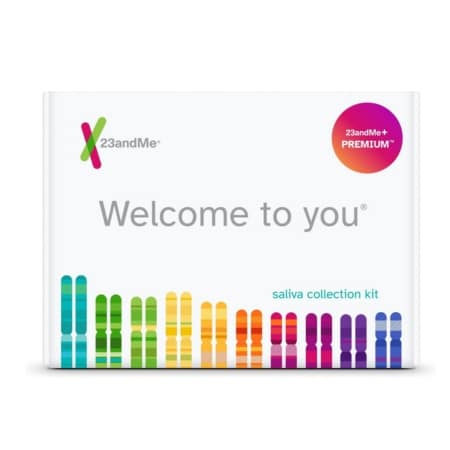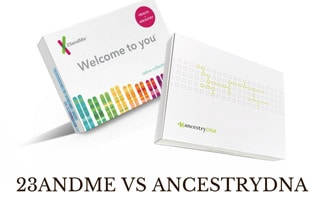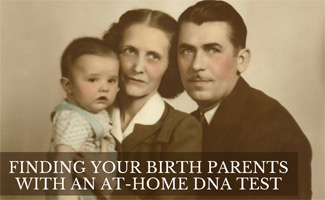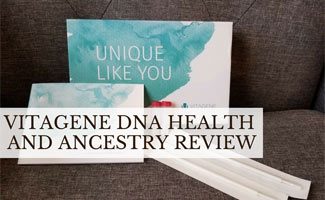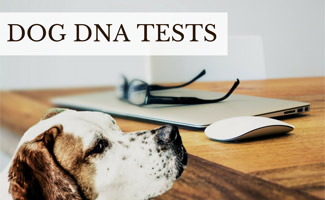23andMe Review: You Won’t Believe What I Discovered
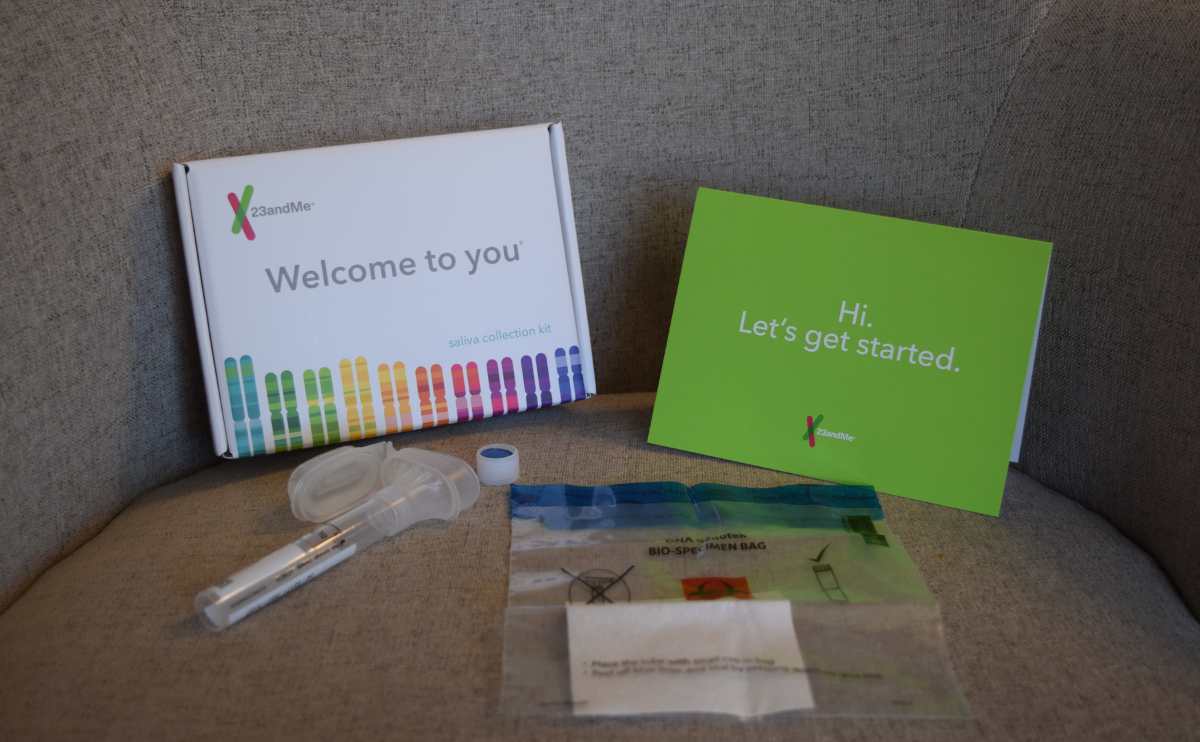
Wondering if you’ll be diagnosed with a genetic disease later in life? Could the condition skip you but be passed on to your children? 23andMe can help you better understand your possible health risks. What is 23andMe? This popular DNA testing service stands out from the increasingly crowded direct-to-consumer DNA testing industry for its unparalleled ability to give you inherited disease risk information.
What else is included in 23andMe results? 23andMe is also a solid contender for DNA ancestry testing if you want to find out about your family’s roots and match with relatives. But that’s not all. I’ll shed light on everything you can expect from this service and give you my firsthand experience taking its Health + Ancestry DNA test.
Visit 23andMe’s Website | View on Amazon
-
DNA Tests Offered - 80%
80%
-
Storage & Privacy Policy - 95%
95%
-
Pricing - 80%
80%
-
Online Community - 80%
80%
-
Customer Support - 90%
90%
Pros
Only at-home DNA test to offer FDA-approved health screenings Large database of 5 million people Provides your ethnicity breakdown from 1,000+ global regions CLIA and CAP certified laboratory (third-party lab) Test samples and results are secure for privacy Provides chromosome browser to compare shared chromosomal segments Stores your DNA sample Gives you raw DNA results
Cons
Doesn’t offer separate, in-depth Y-DNA or mtDNA testing No genealogical DNA projects available to join on website Can’t upload raw DNA data from other services Genealogical community forums are lacking compared to our top two choices Users have to opt-in to allow others to even see that they’re a genetic match (members say many don’t, making it more difficult to identify and connect with living relatives)
Consumer Reviews
This is the aggregate score of reader reviews we’ve received. Have a good or bad experience with 23andMe? Feel free to leave your own review in the comments. Please note that only ratings with valid review content will be published and counted.
11 Key Features
- Offers 4 different test kits.
- Only requires a saliva sample.
- Results available in 6-8 weeks.
- Get ethnicity results from 2,570+ global regions.
- One of the very few services that analyzes Y-DNA and mitochondrial DNA to give you your haplogroup (from an autosomal DNA test).
- Find and connect with relatives in the 23andMe database who share DNA with you (must opt in).
- Automatic Family Tree Builder.
- Only at-home DNA testing service with authorization from the U.S. Food and Drug Administration (FDA) for genetic testing for disease predisposition.*
- 23andMe+ Total Health: a new test that utilizes the latest cutting-edge genetic analysis technology called Whole Exome Sequencing (WES). Researchers estimate that 85% of all genetic variants that cause diseases can be found in the exome (the coding portion of the genome).
- 45+ carrier status reports including cystic fibrosis, sickle cell anemia, and hereditary hearing loss.
- 6 pharmacogenetics reports to discover how your DNA may impact how your body processes certain medications (2 higher-tiered plans)
*Approximately one dozen testing reports are FDA-approved; the others are powered by 23andMe’s research but are not FDA-approved. Some of the approved tests include late-onset Alzheimer’s, Parkinson’s, Hereditary Thrombophilia, Type 2 Diabetes, and 44 genetic variants found on the BRCA1 and BRCA2 genes known to be associated with a higher risk for breast, ovarian, and prostate cancer.
How Much Is 23andMe?
| Ancestry | Health + Ancestry | 23andMe+ Premium | 23andMe+ Total Health | |
|---|---|---|---|---|
| Price | $99.00 | $129.00 | $139.00 | $1,188/year |
| Ancestry Results & Relative Finder |  |  |  |  |
| Trait Reports |  |  |  |  |
| Health Predisposition Reports | 10+ | 40+ | 40+ | |
| Carrier Status Reports |  |  |  | |
| Wellness Reports | 5+ | 10+ | 10+ | |
| Pharmacogenetics Reports |  |  | ||
| Ongoing New Health Reports |  * * |  | ||
| Exome Sequencing |  | |||
| Blood Testing | Add-on | 2 per year |
My Personal Experience With 23andMe
In 2018, Exploring Life’s Mysteries purchased a 23andMe Ancestry + Health DNA testing kit for me to try and review. After submitting my results the first time, they came back “insufficient to produce genotyping results.” 23andMe said this is uncommon but does occur occasionally, so the company sent me a replacement kit. I was worried I’d have to wait another 4+ weeks for my results, but the results came quickly.
My 23andMe Results
There are several categories of results from my 23andMe Ancestry + Health DNA test: Ancestry, Carrier Status, Genetic Health Risk, Traits, and Wellness. I’ll briefly discuss the main takeaways from each report to give you an idea of what you could expect if you submit a sample to 23andMe.
Genetic Health Risk Results
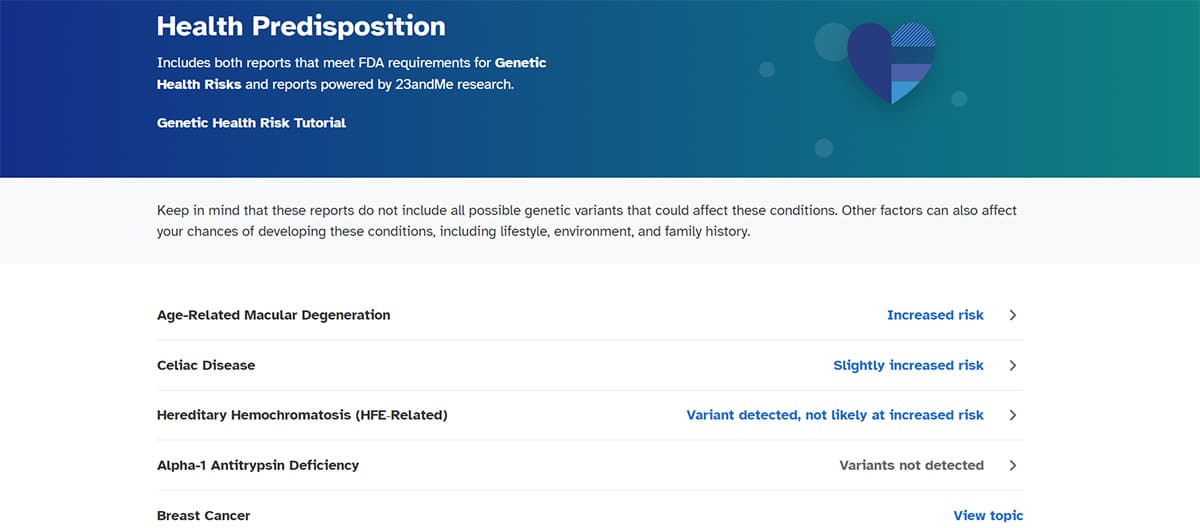
I have 4 out of 14 highlighted reports for genetic health risk:
- Age related macular degeneration (vision loss in older adults)
- Celiac disease (consumption of gluten damages the small intestine)
- Hereditary hemochromatosis (HFE-related) (absorption of too much dietary iron)
- Type 2 diabetes (my report says that my genetics are associated with a typical likelihood of developing type 2 diabetes)
I was pretty pleased with these results. Not that these four conditions couldn’t be serious, but there were other reports I was more concerned about that came back undetected such as:
- BRCA1/BRCA2 (associated with an increased risk of developing breast and ovarian cancer and other types of cancer)
- Late-onset Alzheimer’s Disease (memory loss, cognitive decline, and personality shifts)
- Parkinson’s Disease (tremors, muscle stiffness, and problems with movement)
Do You Want To Know Your Risks?
I shared the results with my husband and we were ecstatic. Although I could still fall ill with one of these diseases, it’s comforting knowing the variants tested were undetected.
My husband stated that he could never read results like this because he would take negative results as a death sentence. I don’t blame him one bit. I’m very fortunate with the results I received and understand why someone may opt out of reading the health risk results.
23andMe warns users about the anxiety or depression you may feel if you receive health results that are less than ideal. I think this is important because it shows that 23andMe cares about its customers and doesn’t want the test results to cause stress.
I’ve always been a curious person and like to know as much as possible about something ahead of time to help prepare me. Although reading results that I had an increased risk for certain cancers, Alzheimer’s, or Parkinson’s would’ve been terrible to learn, I would also be happy to know that I could come to terms with the possibility of developing those diseases sooner rather than later.
I realize it’s easy to say that is how I would react, but I genuinely believe that. My mother was diagnosed with ALS (Amyotrophic Lateral Sclerosis), also known as Lou Gehrig’s Disease, in 2016 and died in 2017. I spent the months following her diagnosis researching and learning everything I could about the disease and how she could live longer (which I now regret). Up until that point in my life, I’d never experienced a truly helpless situation like ALS where there was nothing I could do to fix it. The information was helpful, but I wish I had spent that time calling her on the phone and spending more time with her instead of trying to find a cure for her.
This is why I feel relatively confident saying if I were faced with a similar situation, I would focus on the time remaining with loved ones because of my experience with my mother’s ALS. Looking back, it was a distraction for me to prevent growing even closer to her and suffering even more heartbreak when she died. I didn’t know that’s what I was doing then, but it was early in my adult years, and hindsight is 20/20.
Carrier Status Results
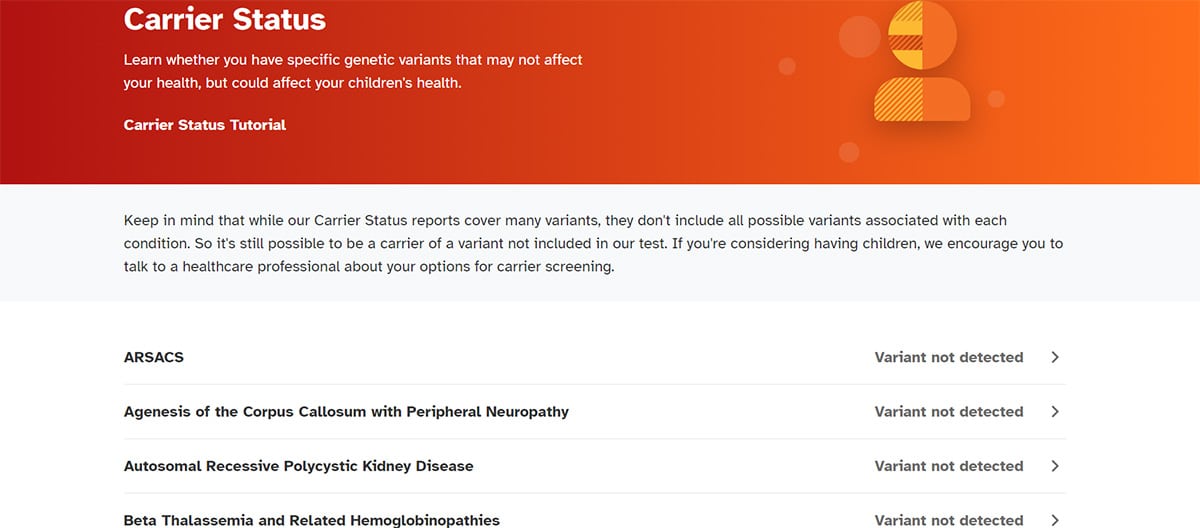
My carrier status report revealed that I had no variants detected for the 46 genetic variants they tested for. I was ecstatic about this. Knowing that the variants 23andMe analyzed were not detected in my saliva gives me a little peace of mind knowing that my children may not have an increased risk of developing some diseases. (Although, 23andMe notes for all of its tests that diseases can still occur because it does not test for every variant possible.)
Traits Results
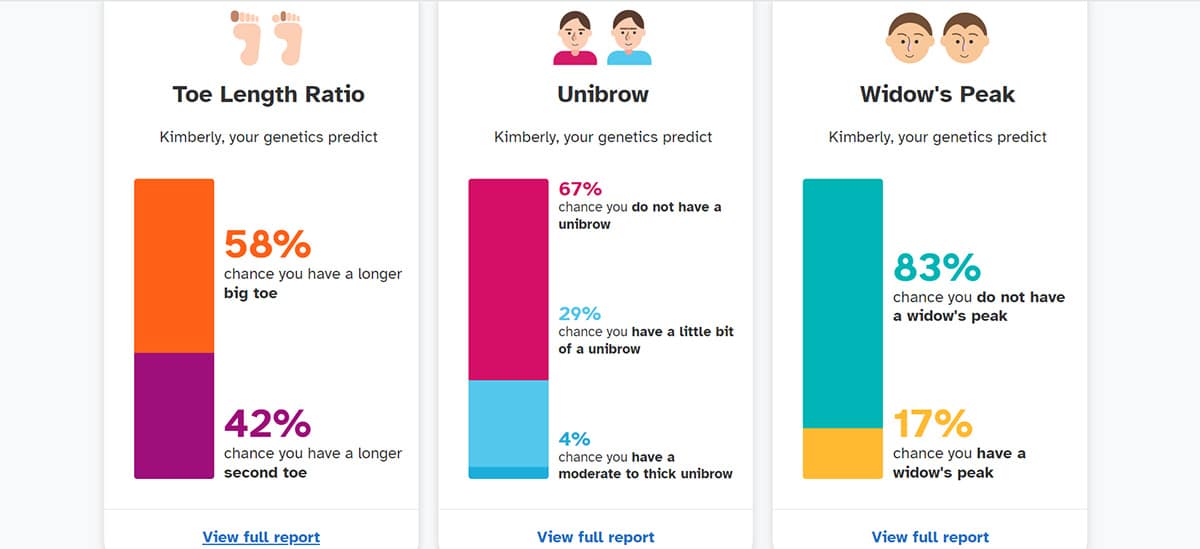
23andMe uncovers how your genes may affect over 30 different traits. The physical, taste, and smell features were spot on for me. There’s a Weird & Wonderful section with interesting tidbits like my ability to match musical pitch, mosquito bit frequency, motion sickness, and more. I would’ve never guessed that these types of things can be discovered in my DNA
It’s fascinating how one DNA sample can give them insight into the genetics behind my traits. My physical trait findings were accurate and unsurprising. The ability to gauge whether I prefer sweet or salty snacks and dislike cilantro was shocking to me. The things that can be detected in DNA are fascinating.
Wellness Results
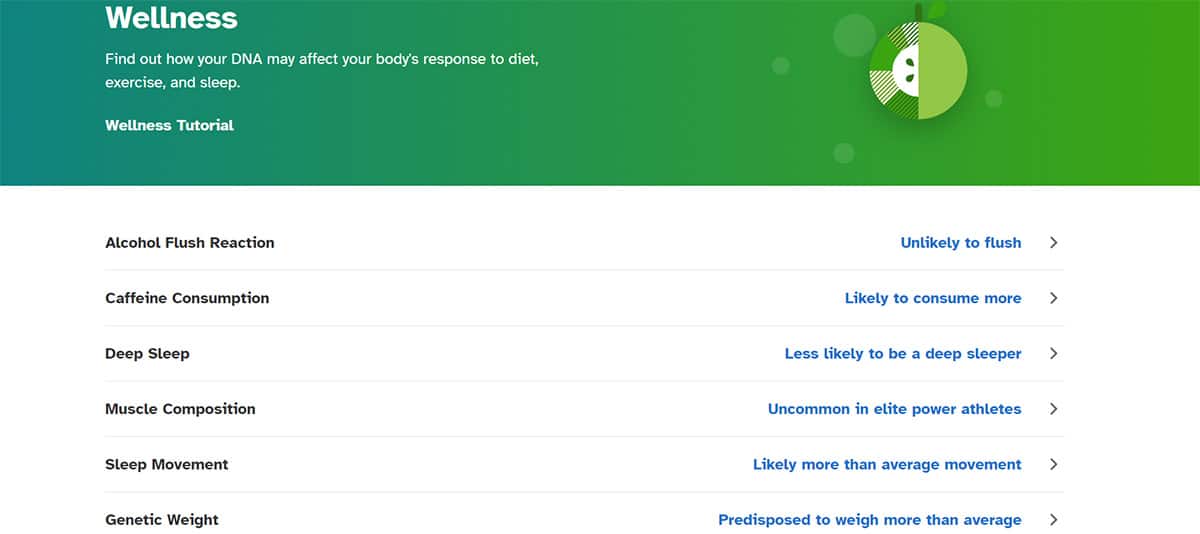
My wellness results highlighted 8 reports. Some of the things 23andMe tested for were random, such as how likely I am to flush bright red after drinking alcohol, but still a fun fact to learn about. I was more interested in muscle composition, genetic weight, lactose intolerance, and others.
Learning about my genetic weight was fascinating. I’ve never thought much about what impacts weight, but I wouldn’t have guessed that my European descent is a factor. Reading up on how my DNA sample is used to determine my result is fascinating. According to my DNA, I am predisposed to weigh about 6% more than average for someone my age, birth sex, and height.
Ancestry Composition Results
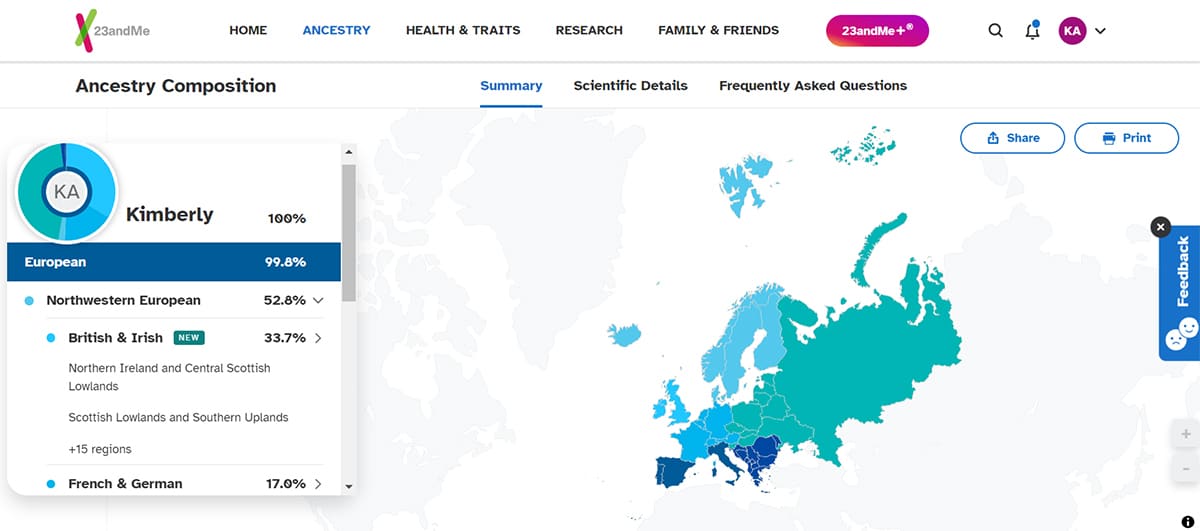
23andMe stands out for its in-depth ancestral breakdowns covering over 2,750 global regions. Listed beneath each regional population percentage, you may also find matches to groups of people who share more recent ancestry with you.
My ancestry report was pretty uneventful, but I don’t mean that in a bad way. My maternal grandfather has a book dating back multiple generations that includes family tree information and our ancestry composition. I remember as a young girl doing a class project on my family’s heritage and that book was extremely helpful.
23andMe’s results for my ancestry report confirmed everything I already knew, which gives me peace of mind knowing that the results and the book were similar.
Haplogroup Reports
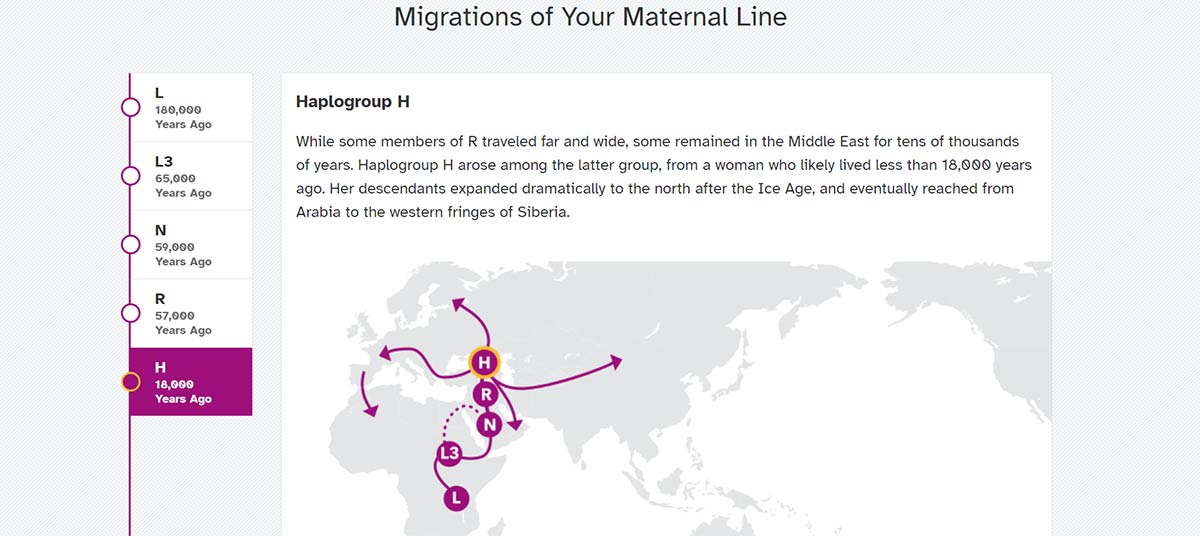
23andMe is one of the very few direct-to-consumer autosomal DNA tests that provide both maternal and paternal haplogroups. A haplogroup is an ancestral grouping of people who share a common ancient ancestor on either their paternal line (Y-chromosome DNA) or maternal (through mitochondrial DNA). Keep in mind that only males have a paternal haplogroup because fatherlines can only be analyzed from a male’s Y-chromosome DNA.
I learned that my maternal haplogroup is H1a3. While the H haplogroup traces back an estimated 18,000 years, my H1a3 branch most recently traces back to a woman who lived approximately 5,000 years ago. In this section, 23andMe provides detailed descriptions of your haplogroup. It was fascinating to learn all of the ancient history behind my maternal-line ancestors.
Other Ancestry Reports & Tools
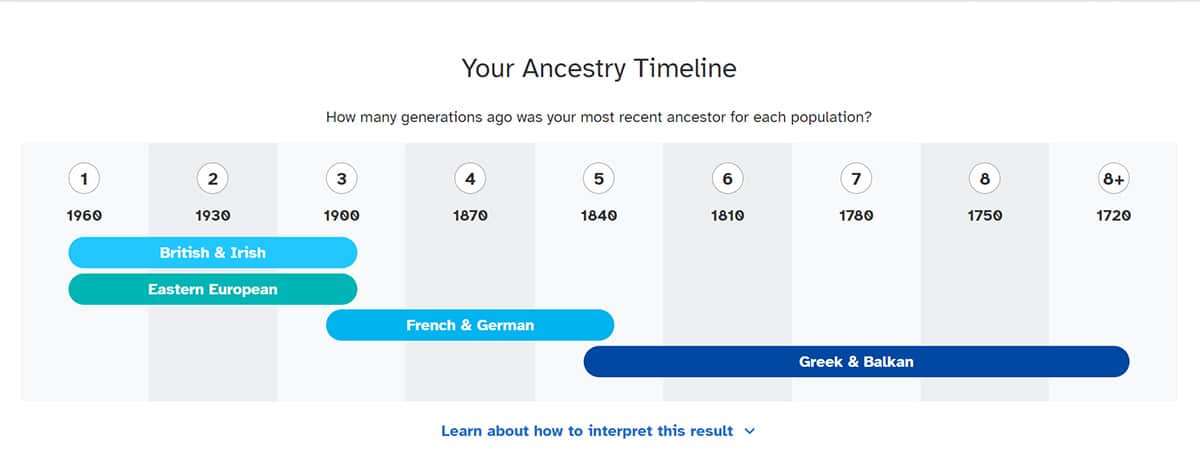
What else can you learn about your ancestry through 23andMe? There’s a lot of information to go into great detail, but here’s a summary of what you can expect to discover.
- Neanderthal DNA: Discover how much DNA you share with Neanderthals. I learned that I have <2% Neanderthal DNA but more than 51% of 23andMe customers
- Ancestry Timeline: See a generational timeline of your main ethnicity groups.
- DNA Relatives List: View other 23andMe customers who share DNA with you, from immediate family members out to 4th cousins. I have 1,500 matches in 23andMe!
- Historical Matches: Uncover your historical and ancient relatives (requires 23andMe+ Premium)
23andMe VS The Competition
I consulted with our DNA testing and genealogical expert at Exploring Life’s Mysteries to see how 23andMe’s ancestry features compare to other top ancestry DNA tests. Unfortunately due to 23andMe’s recent data breach, the company has “temporarily” disabled many of its features, most notably the chromosome browser and being able to see matches you have in common with a match. This renders 23andMe far less effective in doing DNA genealogy research compared to AncestryDNA and FamilyTreeDNA.
Registering My 23andMe Kit
This process was super simple. All I had to do was use the code on the side of the test tube and create an account on 23andMe’s website. The website also let me know which step my kit is in throughout the testing process.
Providing The Saliva Sample
23andMe made this extremely simple. There were clear directions on how to fill the test tube with saliva and a marked “Fill To” line. (Note, if you do a 23andMe test, you want the spit to be to the fill line, not the bubbles. Additionally, make sure you don’t eat or drink anything 30 minutes before completing the sample.)
After I filled the tube with my saliva, I added the solution cap and shook it for about 5 seconds, per the directions. I then removed the solution cap and added the regular cap to prepare the sample for shipment. The kit came with a prepaid return box, which had directions on it as well.
I loved that the box was small and could be dropped off in a USPS collection box or placed in a mailbox. (Not waiting in long lines at USPS is always a plus in my book!) It was straightforward to place the test tube in the sealed bag and the return box and send it off for testing. The box included a tracking number on it which is handy to see when the lab will receive my results.
What Comes In A 23andMe Kit?
Take a look at what’s included in a 23andMe Ancestry + Health DNA kit in the unboxing video below.
23andMe Competitors
Below are some critical differences between 23andMe and its competitors.
23andMe vs African Ancestry
- African Ancestry focuses solely on Africa, whereas 23andMe is worldwide.
- African Ancestry has more limited results than 23andMe does.
- 23andMe can test for health and ancestry, African Ancestry only tests ancestry.
23andMe vs AncestryDNA
- AncestryDNA’s database has 22 million people compared to 23andMe, which has 13 million people.
- 23andMe removed their genealogical community forums, while AncestryDNA’s forums are a huge plus for helping with genealogical research.
- Easier to connect with genetic matches on AncestryDNA versus 23andMe.
23andMe vs FamilyTreeDNA
- 23andMe’s database has 13 million people compared to FamilyTreeDNA’s, which is just over 2 million people.
- FamilyTreeDNA doesn’t offer any DNA testing for genetic health risks.
- FamilyTreeDNA offers autosomal DNA and in-depth Y-DNA and mtDNA testing kits. 23andMe only offers Autosomal DNA testing, although 23andMe does give you your motherline and fatherline haplogroups.
23andMe vs MyHeritage DNA
- 23andMe offers health-related DNA results, while MyHeritage does not.
- The MyHeritage DNA test kit is significantly less expensive than 23andMe’s tests.
- MyHeritage has a highly active online community; 23andMe does not.
Frequently Asked Questions
Here are some questions consumers often ask about 23andMe. Don’t see your question here? Hit us up in our comments.
Is 23andMe Accurate?
In terms of genetic health risks, yes, 23andMe is accurate — but only for the genetic variants they test for. Keep in mind that reports do not include all possible risk variants; so you could still have an increased risk of a disease even if the report says you’re clear. Why? Science is still evolving, and many variants haven’t yet been identified by researchers.
For ethnicity breakdowns, the answer to this question is: it depends on where your ancestors lived and how 23andMe deciphers your DNA compared to its population groups. Every DNA testing service has its own population breakdown across the world. 23andMe has the broadest breakdown of regional populations.
How Long Does 23andMe Take?
23andme processing time takes anywhere from 6-8 weeks once the lab receives your DNA sample. I was pleased with my turnaround time — as many other users have shared in online reviews. However, I did find some customer reviews complaining about how long it took to get results.
Does 23andMe Tell You Your Blood Type?
No, 23andMe’s at-home testing kits don’t provide you with your blood type. The only exception is if you’re a 23andMe Total Health member and have your clinician request blood work from 23andMe. In most cases, it’s less expensive to have your doctor do a simple blood type test.
What Is 23andMe’s Privacy Policy?
23andMe doesn’t share your genetic data with employers, insurance companies, public databases, or third-party marketers without your explicit consent. The company also states, “We will not release any individual-level personal information to law enforcement unless we are required to do so by court order, subpoena, search warrant or other requests that we determine are legally valid.” This policy is in line with those of AncestryDNA and other top services.
With your DNA sample, 23andMe says it’s up to you whether the lab destroys your sample or securely stores it. Also regarding your 23andMe profile, you must opt into the DNA Relatives tool, and you can control what information is shared with DNA matches.
What About The 23andMe Data Breach?
It’s important to mention, however, that 23andMe suffered a massive data breach in the fall of 2023. Hackers gained access to nearly seven million people’s ancestry data. 23andMe stated that its investigation revealed that the only information involved was from users’ Family Tree profiles and self-reported location (city/zip code) and birth year in the DNA Relatives feature. The company has since temporarily disabled some features within the DNA Relatives tool as an additional precaution to protect privacy.
Am I Happy With My 23andMe Results?
Visit 23andMe’s Website | View on Amazon
Overall, I’m pleased with my experience with 23andMe. It’s fun to learn more about my ancestry and health and I can share the information with other family members. If you’re someone who has low anxiety and doesn’t stress out too easily, then I’d recommend this test to you.
However, if finding out you have variants in your DNA that are associated with fatal illnesses will weigh on you, I recommend choosing an ancestry-specific DNA test and not one that includes health results. Find out how 23andMe stacks up against its top DNA ancestry test competitors in our in-depth reviews of AncestryDNA, FamilyTreeDNA, and Living DNA. You may also want to check out our reviews of the best DNA tests for health and diet to see alternatives to 23andMe.
What did you learn from your 23andMe test or another DNA test you’ve taken? Let us know in the comments.
Why Trust Exploring Life’s Mysteries?
This review was a collaborative effort between test-taker Kimberly Alt and Sally Jones, our team’s DNA, health, and ancestry expert. Kimberly’s maternal grandparents have countless documents about previous familial generations. For this article, we felt she was a great candidate to test 23andMe because most of the ancestry information could be fact-checked. Throughout her education, Kimberly worked on many ancestry and genetic projects and continues to research them in her free time.
Sally has over 20 years of experience in human health sciences communications. She has extensively interviewed and reported on many of the world’s top scientists in such fields as genetics, cancer, infectious diseases, and much more. She’s also conducted genealogical research into her family’s history for years. Kimberly and Sally are part of Exploring Life’s Mysteries’s professional team of experts who test and research products to make our lives smarter and safer for us, our families, and our readers.

